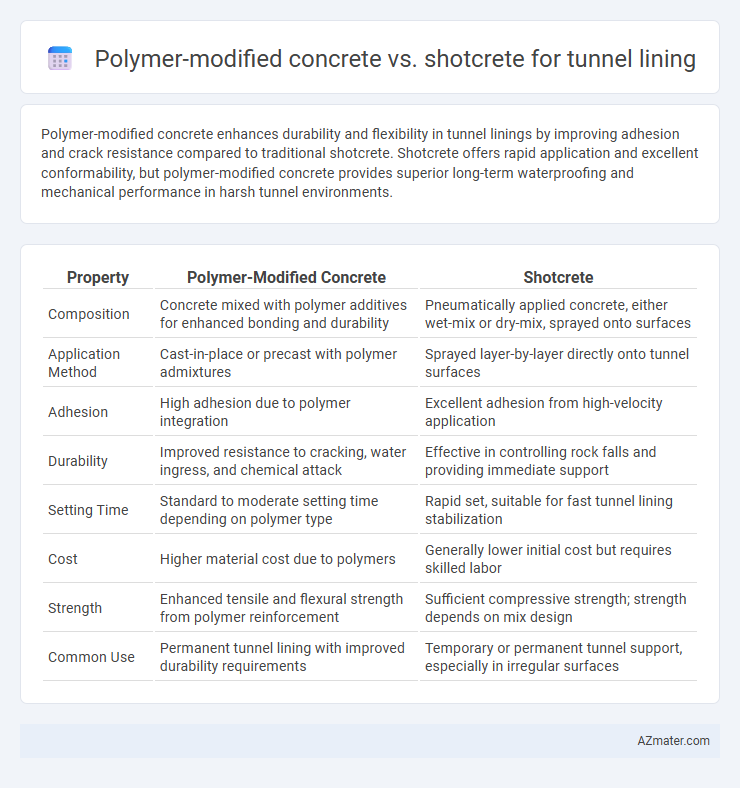Polymer-modified concrete enhances durability and flexibility in tunnel linings by improving adhesion and crack resistance compared to traditional shotcrete. Shotcrete offers rapid application and excellent conformability, but polymer-modified concrete provides superior long-term waterproofing and mechanical performance in harsh tunnel environments.
Table of Comparison
| Property | Polymer-Modified Concrete | Shotcrete |
|---|---|---|
| Composition | Concrete mixed with polymer additives for enhanced bonding and durability | Pneumatically applied concrete, either wet-mix or dry-mix, sprayed onto surfaces |
| Application Method | Cast-in-place or precast with polymer admixtures | Sprayed layer-by-layer directly onto tunnel surfaces |
| Adhesion | High adhesion due to polymer integration | Excellent adhesion from high-velocity application |
| Durability | Improved resistance to cracking, water ingress, and chemical attack | Effective in controlling rock falls and providing immediate support |
| Setting Time | Standard to moderate setting time depending on polymer type | Rapid set, suitable for fast tunnel lining stabilization |
| Cost | Higher material cost due to polymers | Generally lower initial cost but requires skilled labor |
| Strength | Enhanced tensile and flexural strength from polymer reinforcement | Sufficient compressive strength; strength depends on mix design |
| Common Use | Permanent tunnel lining with improved durability requirements | Temporary or permanent tunnel support, especially in irregular surfaces |
Introduction to Tunnel Lining Technologies
Polymer-modified concrete enhances tunnel lining durability by improving adhesion, flexibility, and resistance to chemicals, making it suitable for challenging subterranean environments. Shotcrete, or sprayed concrete, offers rapid application and excellent bonding to irregular surfaces, optimizing construction speed and structural integrity in tunnel linings. Comparing these technologies highlights polymer modification's material performance benefits versus shotcrete's operational efficiency in tunnel construction.
Overview of Polymer-Modified Concrete
Polymer-modified concrete (PMC) for tunnel lining incorporates polymers to enhance adhesion, flexibility, and chemical resistance, making it superior in durability compared to conventional concrete. This modification improves resistance to water infiltration and environmental degradation, crucial for maintaining tunnel structural integrity. PMC also offers better bonding with reinforcement materials, reducing maintenance costs and extending service life.
Shotcrete: Definition and Applications
Shotcrete is a method of applying concrete projected at high velocity onto surfaces, commonly used for tunnel lining due to its excellent adhesion and rapid setting properties. It provides structural support and waterproofing in excavation sites, rock stabilization, and underground construction projects. Shotcrete's versatility allows for complex shapes and contours, making it ideal for reinforcing irregular tunnel profiles and enhancing overall durability.
Material Properties and Performance Comparison
Polymer-modified concrete enhances tunnel lining durability through improved tensile strength, reduced permeability, and superior chemical resistance compared to traditional shotcrete, making it ideal for harsh environments. Shotcrete offers rapid application and excellent adhesion, but typically exhibits lower compressive strength and higher porosity when unmodified. The choice depends on specific project requirements where polymer modifications provide longer service life and resistance to cracking in aggressive underground conditions.
Installation Techniques and Equipment
Polymer-modified concrete for tunnel lining requires precise mixing equipment and is typically placed using formwork or shotcrete methods, relying on standard concrete pumps and sprayers adapted for high-viscosity materials. Shotcrete, applied pneumatically through dry- or wet-mix processes, uses specialized shotcrete guns and robotic arms, enabling rapid, layer-by-layer application without forms, suitable for irregular surfaces and complex geometries. Installation of polymer-modified concrete emphasizes controlled curing conditions and equipment calibration to ensure adhesion and durability, while shotcrete installation prioritizes nozzle velocity and rebound management to optimize material placement and minimize waste.
Cost Analysis: Polymer-Modified Concrete vs Shotcrete
Polymer-modified concrete often incurs higher initial material costs compared to shotcrete due to the addition of polymers enhancing bonding and durability. Shotcrete, applied pneumatically, reduces labor and formwork expenses, leading to lower overall installation costs in tunnel lining projects. However, polymer-modified concrete's longer service life and resistance to chemical attack can result in lower maintenance costs, affecting the total cost analysis over the tunnel's lifecycle.
Durability and Long-Term Performance
Polymer-modified concrete enhances tunnel lining durability by improving crack resistance, adhesion, and impermeability compared to traditional shotcrete, which relies on rapid application but may suffer from lower cohesion and potential porosity. Long-term performance of polymer-modified concrete is superior due to its ability to withstand chemical attacks, freeze-thaw cycles, and mechanical stress, extending service life and reducing maintenance needs. Shotcrete, while efficient for initial lining applications, often requires additional protective coatings or repairs to maintain durability over time in aggressive tunnel environments.
Environmental Impact and Sustainability
Polymer-modified concrete significantly reduces permeability and enhances durability, decreasing maintenance frequency and the associated environmental footprint in tunnel lining applications. Shotcrete, while offering rapid application and reduced formwork waste, may have higher rebound loss and energy consumption during projection, impacting sustainability metrics. Utilizing recycled aggregates and low-VOC polymer additives in polymer-modified concrete can further improve environmental outcomes compared to conventional shotcrete methods.
Common Challenges and Solutions
Polymer-modified concrete and shotcrete both face challenges such as adhesion issues, shrinkage cracking, and durability under aggressive tunnel environments. Solutions include optimizing polymer content to enhance bonding strength and flexibility, employing fiber reinforcement to reduce cracking, and using proper curing techniques to improve long-term performance. Both materials require precise mix design and application methods to ensure effective tunnel lining durability and structural integrity.
Choosing the Right Tunnel Lining Method
Polymer-modified concrete offers enhanced durability and chemical resistance ideal for long-term tunnel lining performance, while shotcrete provides rapid application and excellent adhesion on complex geometries. Selecting the right tunnel lining method depends on project-specific factors such as environmental conditions, structural requirements, and construction speed. Evaluating cost-effectiveness, setting time, and mechanical properties ensures optimal performance for tunnel safety and longevity.

Infographic: Polymer-modified concrete vs Shotcrete for Tunnel lining
 azmater.com
azmater.com